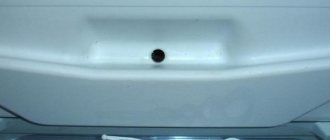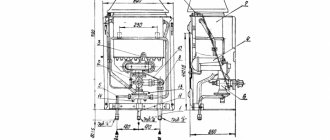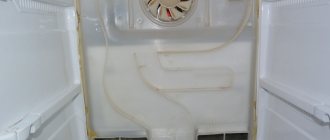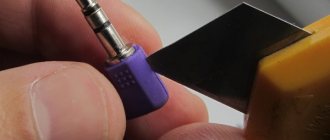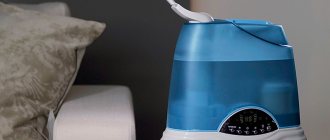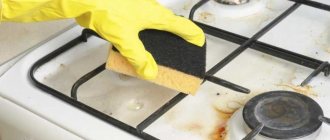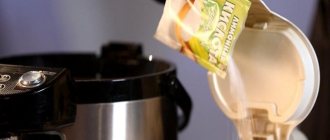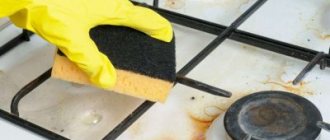Precautions when working at home
There are many ways to eliminate dents on kitchen appliances , however, if you have never repaired metal surfaces before, the existing problem can only be aggravated by damaging the thin steel of the case with careless action.
ADVICE! If a dent has formed on the door of a household appliance, you should not dismantle it to fix the problem, since these actions can lead to a violation of the tightness of the appliance part.
In addition, some methods of correcting the defect may be unsafe for your health. Therefore, before starting work, carefully study the precautions to prevent damage to the device and deterioration of health:
- the use of a method that involves using a rubber hammer and trowel to remove a dent requires extreme care, attentiveness and strict adherence to process technology;
- the temperature of solid carbon dioxide is about 80 ⁰C below zero, so when starting to work with it, be sure to wear thick gloves on your hands. Otherwise you will get severe frostbite.
ATTENTION! Another dangerous property of dry ice is that if you use it in a poorly ventilated room, the concentration of carbon dioxide in the air sharply increases, as a result of which loss of consciousness is possible. Prolonged inhalation of evaporating carbon dioxide increases the risk of respiratory arrest and death.
When using the method of eliminating a defect from a refrigerator with dry ice, be sure to open the windows and do not close them for some time after the repair.
Have you removed dents from your refrigerator before?
Not really
Getting rid of damage using a suction cup
Most car owners know that using a pneumatic straightening suction cup can quickly eliminate small and large damage to the car body without first removing the paint layer.
This tool is also suitable for removing dents from the surface of a household appliance:
- clean any existing dirt, degrease the damaged area of the refrigerator;
- attach the suction cup to the defect so that the edges of the tool fit tightly to the metal surface;
- pump out the air from the internal cavity (the space between the suction cup and the outside of the refrigerator);
- After removing the air and ensuring reliable adhesion of the device to the electrical device, proceed to remove the dent: slowly pull the suction cup handle in the desired direction, pulling the metal to the required level;
- blow air, thereby disconnecting the tool from the surface of the kitchen appliance.
If you don’t have a professional vacuum device, try removing a small dent using an ordinary plunger.
ATTENTION! The use of a suction cup is only permissible if the paintwork of the refrigerator is not damaged.
Another convenient way to correct unevenness is to use a mini-lifter to remove dents on the car body .
The tool consists of a centrally located pin for the suction cup fungus and two rubber feet, which allow the device to be securely fixed to the surface and eliminate the risk of damage to the paintwork.
Using the tool you can remove dents up to 8.5 cm in size:
- clean from dirt, degrease the damaged surface, wipe it dry;
- select a fungus piston that is suitable in shape and size for the problem area;
- Apply hot glue to the piston, place the fungus on the defect, wait for the composition to crystallize (30-50 seconds);
- place the rubberized feet of the tool so that the central pin is located exactly above the glued piston, and insert the mushroom mount into the minilift adapter;
- Press the handles of the tool several times, repeat the movements until the dent is completely leveled. Remove the fungus using hot melt adhesive remover.
IMPORTANT! It is strictly forbidden to remove adhesive residues with sandpaper, a knife or other sharp objects.
Useful information: how to clean the drainage hole in the refrigerator.
Methods for eliminating defects
Currently, there are several methods for successfully removing dents from a refrigerator; let’s look at the main ones.
Application of temperature difference
Considering the fact that metal is subject to thermal expansion/contraction, it is possible to restore a problem area with minor defects through temperature influences. Moreover, a regular hairdryer can be used as a heat source, while dry ice wrapped in a soft rag or an aerosol can with compressed air (used for cleaning laptop and PC keyboards) can be used as a cold source.
The recovery procedure itself in this case involves the following:
- The defect area is cleaned of contaminants (grease, stains, etc.) using detergent and wiped dry;
- The area where the dent is formed is uniformly heated using a hairdryer. Here you need to be careful and prevent overheating of the paint and varnish coating of the refrigerator;
- The heated area is sharply cooled using dry ice (a bag of ice is made in a circular motion over the area of heating) or compressed air.
After three or four repetitions of the above algorithm, the dent should level out.
However, it should be understood that a dent is an area of metal with high internal stress, and by influencing the problem area with high and low temperatures, we are trying to reduce this stress to its nominal value. Therefore, if nothing works out for you, then you should resort to a more radical option, described below.
A vacuum can help straighten out the dent.
You don't need to be a specialist to understand that a dent can be leveled out by vacuuming (trying to pull the metal towards you). For these purposes, you can use a regular plunger, or a special device for removing dents on a car.
straighten out the dent with a plunger
If we talk about the first option, then the plunger is applied to the deformed area and by creating an internal vacuum, the handle is pulled towards itself. For minor damage, this force may be sufficient to correct the defect.
The car device is more practical and will allow you to cope with even more significant dents. The work algorithm in this case is as follows:
- The surface is cleaned of dust and grease deposits.
- The device is fixed to the refrigerator body so that the suction cup is in the middle of the dent.
- The working suction cup is attached to the damaged area.
- The screw is unscrewed in order to pull the metal towards you. This procedure should be performed with extreme caution so as not to deform the smooth areas of the body.
- After completion of the work, the mechanism is dismantled.
- The remaining traces from the suction cups are washed off with ordinary detergent.
It should be noted that when using this device, it may be necessary to repeat the pulling procedure several times (up to 10 times), plus irreparable defects in the form of small distortions may still remain on the surface of the refrigerator.
Using a trowel and rubber hammer
This method is suitable if the area of the surface defect is significant. To work, you will need a rubber hammer and a trowel - a spatula for plastering or working with tiles:
- degrease the problem area on the refrigerator;
- turn on the hair dryer and warm up the dent. Make sure that the temperature applied to the damaged surface is not too high. Otherwise, there is a risk of damaging the paint layer.
- turn off the hair dryer, place the trowel on the unevenness so that the spatula completely covers the defect;
- Lightly tap the entire surface of the trowel with a rubber mallet;
- As a result of the manipulations, the dent will straighten.
IMPORTANT! It is unacceptable to use a metal hammer instead of a rubber one to implement this method. Movements during the process of tapping the tool on the trowel should be leisurely and light.
Hammer and trowel
There is a risky way to fix a dent on a refrigerator door using a rubber hammer. This method can be used by experienced craftsmen directly involved in a similar type of work. Initially, you need to degrease the metal, then heat the area with the dent using a hairdryer and press the trowel onto the damaged surface. Next, tap lightly on the shoulder blade with a hammer. During the vibration process, a resonance of the surfaces will occur, and the dent will take the correct position.
Applying the effect of thermal expansion
The method is based on the property of all physical bodies to expand under the influence of high temperature . Contraction of the metal surface after heating can help straighten the resulting dent on its own:
- clean the problem area from contaminants and degrease it;
- take a hair dryer. If you don’t have a tool, a household device designed for drying hair will do;
- turn on the device, direct the hot air stream to the damaged area of the refrigerator;
- Apply the hairdryer to the defect for 30-60 seconds. The temperature of the appliance should be average to eliminate the risk of damaging the integrity of the seal located between the internal and external walls of the refrigerator;
- Turn off the hair dryer, fill a spray bottle with cold water and spray it onto the hot surface.
REFERENCE! If the method does not bring a positive result after the first procedure, repeat all steps 2-3 more times.
Step-by-step instructions on how to defrost a Bosch refrigerator are provided here.
How to remove with a hairdryer and dry ice on a stainless steel device?
To work you will need a hair dryer and granulated dry ice:
- thoroughly wipe the surface with a damp sponge, then degrease and dry it with a paper towel;
- heat the dent with a hairdryer (set to low or medium temperature) for a minute;
- Place ice granules in the center of a small piece of suede fabric, fold the corners of the material to form a bag;
- turn off the hair dryer, apply ice to the defect and rub the entire perimeter of the damaged area in a circular motion.
If necessary, repeat all steps from the beginning.
Removing dents using contrasting temperatures
First you need to prepare a soap solution and thoroughly rinse the damaged surface of the refrigerator.
Then you need to take a hairdryer and heat the dent for a minute. When heated, the metal expands; the main thing is not to overheat the door, otherwise the internal filling may be damaged. You need to purchase dry ice from the pharmacy in advance. To avoid scratches on the refrigerator and to avoid burning your hands, you need to wrap it in a cloth.
For one minute, use circular movements, without pressing, to treat the damaged area. If you did everything correctly, you will hear a pop, which means that the metal has returned to its place. If nothing happens, then repeat the manipulations.
Correcting a defect using compressed air
A can of compressed air (liquid carbon dioxide) is designed to effectively clean dust from your computer and its components.
This product can also eliminate defects on the surface of the refrigerator:
- remove dirt from the problem area, degrease;
- warm the dent with a hairdryer (2-3 minutes), turn off the device;
- put on thick rubber gloves;
- turn the can upside down and spray its contents onto the surface; Continue the process of treating the defect until the dent is covered with frost.
As a result of exposure to a sharp temperature change, the dent will straighten out . After removing the damage, clean the refrigerator from any remaining product with a soft cloth.
REFERENCE! The method using compressed air can be repeated 2-3 more times if the first procedure does not bring results.
Compressed air
Next, we'll look at how to fix a dent on a refrigerator door using a can of compressed air. They are most often used when cleaning computer parts and internal components. It can be used to smooth out damage. When working, you need to lift the bottom of the can up and in this position apply a little compressed air to the surface of the door.
During spraying, cold condensation is released. Under its influence, the metal contracts and takes on its normal shape. If this does not happen, then you can first heat the area with warm air from a hairdryer and repeat the procedure from the beginning. You may have to do the manipulation more than once.
DIY dent decoration
If the defect in kitchen appliances is of significant size and depth, or the paintwork of the appliance is damaged, the dent must be filled with putty to prevent rusting of the metal elements of the appliance.
Putty to the rescue
Removing a dent using putty involves several stages:
- grinding a surface area;
- removal of dust deposits;
- degreasing of metal coating;
- applying an anti-corrosion primer mixture;
- puttying;
- final surface grinding.
Work order:
- to grind dents of significant size, you will need a grinding machine; if the damage is small, sand the top layer of the coating (to the metal) manually using sandpaper with P80 abrasiveness - this grit value of the device is the most optimal, since it allows you to eliminate subsequent shrinkage of the putty mass;
- removing dust with a slightly dampened cloth is a mandatory step, which must be performed both before starting work and after sanding the putty;
- To degrease the surface of the refrigerator, prepare acetone or medical alcohol. Soak a cotton pad in the preparation and thoroughly wipe the cleaned surface;
- Apply a primer mixture to the dent (you can use a composition intended for repairing automobile bodies), wait until it dries;
- Prepare the putty for the procedure according to the instructions included with it. It is desirable that the composition used is also intended for body work;
- Place a small amount of the mixture on a rubber spatula and work it into the dent. If the defect has a significant depth, do not try to fill the concave area with putty at one time: make 3-4 layers, applying each subsequent one after the previous one has set;
- After the composition has hardened, sand the surface with fine-abrasive sandpaper.
Did our advice help you?
Not really
ATTENTION! Removing defects from a refrigerator by puttying has a drawback: the area treated with the mixture differs in color from the rest of the surface, and, in most cases, the device will have to be repainted - partially or completely.
Other decorative products
- Small defects can be easily hidden behind beautiful decorative magnets.
- On the surface of the refrigerator, you can create an abstract geometric composition from strips of colored tape or decorate the household device with an intricate pattern.
- If you know how to draw, buy acrylic paints, a thin brush and try your hand at artistic painting. Before applying the drawing, degrease the surface and use a simple pencil to make a light preliminary sketch of the future image, then start working with paints.
- Napkins for decoupage: choose a suitable product, separate the top layer with the applied pattern and glue the image with any water-soluble glue (for example, PVA). To ensure that the design retains the brightness of its colors for a long time, cover it with several layers of special varnish.
- The easiest and cheapest way to hide dents on the device body is with decorative stickers. Before gluing the image, be sure to degrease the surface of the refrigerator.
Simple and effective ways to remove dents on a refrigerator with your own hands
Equipment care
Minor mechanical damage to the body (dents or scratches) does not affect the operation of the device, but spoils the appearance of the equipment. You can remove dents on a refrigerator at home using a suction cup, straightening, or exposure to contrasting temperatures. If the damage is still noticeable, it can be decorated.
